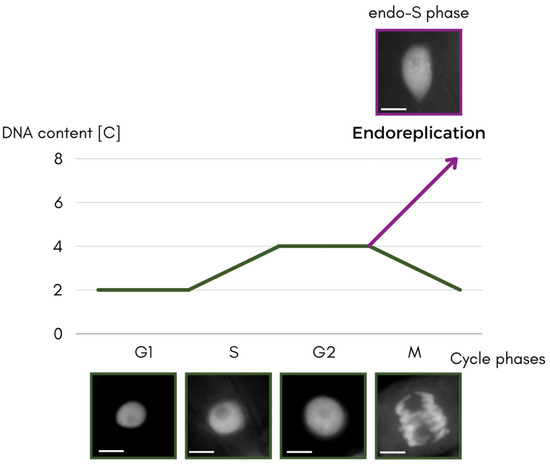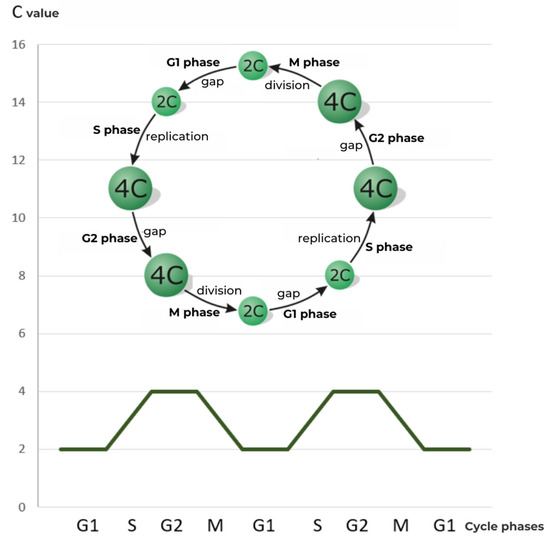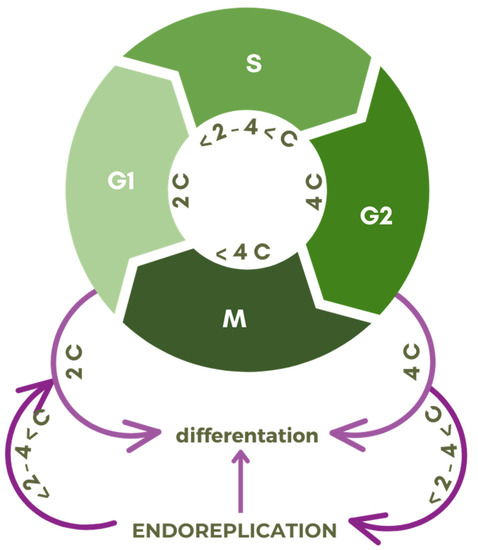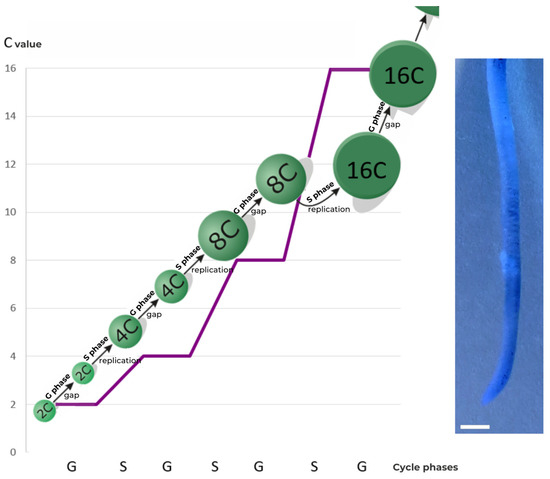The S phase is the gateway to understanding what happens in the non-classical type of cell cycle—the process of endoreplication described here (Figure 1).
Figure 1. Scheme of the separating the paths of the classical cycle and the endocycle, through the cycle phases with DNA content expressed in universal units [C] of the cell nucleus changes. Nuclei of the apical part of roots of Vicia faba ssp. minor seedlings stained with 4′,6-diamidino-2-phenylindole (DAPI) and converted to grayscale. Scale bar is 10 μm.
In the phase ending the classical cycle interphase, G2 (Gap 2), the cell reaches its final size, adequate to the content of the cell nucleus (
Figure 2)
[3]. Now, after one round of replication, the amount of DNA is 4C in vegetative cells and 2C in generative cells
[6].
Figure 2. Scheme of the cell division cycle, with G1, S, G2, M phases, and relative DNA content expressed in universal units [C].
During the classical cycle ending with division, the value of C, characteristic of the G2 phase, decreases to the value of C, which is typical of the G1 phase. Then, the cycle begins anew
[5]. There are cases where unreduced gametes (e.g., diploid instead of haploid) are formed during meiosis; when combined, they create a new organism that is immediately polyploid
[6][8][6,8]. However, it is a different type of polyploidization known as species polyploidy or auto-polyploidy
[9][10][11][12][9,10,11,12], which will not be discussed extensively here, unlike the organo- or tissue-specific endopolyploidy, which occurs during the lifetime of an individual, resulting from endoreplication.
2. Foundations of Endoreplication
Young plant cells are characterized by high proliferation. After some time, those that lie outside the meristems begin to differentiate, which leads to the formation of tissues
[5][13][5,13].
Differentiation (
Figure 3) is associated with numerous changes within the cell in terms of its morphology, function, and biochemical arsenal
[3][14][15][16][3,14,15,16]. The reason for such transformations is the need to shape an appropriate pool of matrices for the production of cellular components
[17][18][19][17,18,19]. Behind the acquisition of the former is a different expression of the desired genes, and in the case of endoreplication, increasing their availability by copying the entire genome, not once, as in the case of the S phase of the classic cell cycle, but multiple times
[1][20][21][22][1,20,21,22].
Figure 3. Scheme of transition points of the cell division cycle with G1, S, G2, M phases, and relative DNA content expressed in universal units (C) to the endocycle (endoreplication).
Endoreplication, called the endocycle, is a succession of G and S phases during which the cell grows and increases the level of its genetic material, which is expressed in the multiplication of the C value
[3][4][3,4].
Endocycles are therefore described as division-free cycles, since the latter would normally reduce the C value by half. This does not occur in the case of endoreplication. Therefore, the cell subjected to it becomes polyploid and has a cell nucleus with an increased DNA content, often many times over, as compared to its basic content (
Figure 4).
Figure 4. Scheme of the endocycle phases and relative DNA content expressed in universal units [C]. Image shows the apical part of root of Vicia faba ssp. minor seedlings, converted using PicosmosTools 2.6.0.1 software (first free version published in Softonic on September 29, 2015, by “Free Time”, England). Scale bar is 2 mm.
3. Endocycle Types
Endocycles come in several forms, which can be distinguished by their different courses and the obtained C value. As the papers
[1][23][24][25][1,23,24,25] report, these forms include endoreduplication, endomitosis, incomplete replication, and amplification.
Endoreduplication
The occurrence of endoreduplication in cells can be recognized by two symptoms. First, in the interphase, there is an increase in the volume of chromocenters, but there is no increase in their basal number. Second, after the interphase, the cell produces chromosomes that are ostensibly similar to those formed in the classical cycle. The chromosomes even align in the equatorial plane during endoreduplication, but they never separate. This gives rise to polythene chromosomes, i.e., structures consisting of many strands of DNA. They can be composed of multiple, even hundreds of, sister chromatids, which depends on the number of rounds of replication within endocycles. During endoreduplication, no karyokinesis or cytokinesis occurs, the spindle does not function, and no phragmoplast is formed
[23].
In low polyploid cells, endoreduplication may be preceded by other types of endocycles. The occurrence of endoreduplication has been described in the seed endosperm and suspensor of many species. And it is, along with endomitosis, the most common cause of polyploidization.
Endomitosis
Endomitosis is a form of endocycle that closely resembles the standard cell cycle. In its course, DNA multiplication takes place, which is visible in the interphase: the number of chromocenters is doubled but their volume is not enlarged. Their number increases exponentially, corresponding to the number of replication rounds performed.
When genetic material condenses, chromosomes analogous to mitotic ones become visible. They line up within equatorial plate, as in the metaphase, and due to the action of the karyokinetic spindle, sister chromatids are separated as in the anaphase. However, they do not reach the poles of the cell as in the telophase, and the karyokinesis is only provisional and not accompanied by cytokinesis
[1]. Other sources say that the karyokinetic spindle does not arise during endomitosis
[26], although such a course of events would cover to some extent the similarity of endomitosis to mitosis.
In each case, one nuclear envelope is finally rebuilt, inside which all chromosomes are locked. A cell is therefore equipped with a multiplied number of chromosomes, centromeres, and nucleoli but still has one cell nucleus.
The aforementioned similarities to the division occurring in the classical cell cycle allowed scientists to distinguish four phases of endomitosis: endoprophase, endometaphase, endoanaphase, and ostensible endotelophase (ostensible due to the fact that this phase is the most divergent from its mitotic counterpart). Therefore, endomitosis could be compared to a cell cycle in which mitosis occurs but is not completed by division
[1][25][1,25].
Incomplete Replication
During incomplete replication, genetic material is duplicated, but in an incomplete volume. Hence, the phenomenon is also referred to as underreplication. This means that the cell nucleus, after the process of incomplete replication, reaches the content of genetic material always slightly below a full multiple of C
[2][24][2,24].
It depends on the needs of the plant, which goes through various stages of development during its life
[2]. The functions performed by cells often require an enhanced expression of only part of the genes present in the genome, while others are redundant at this time. Incomplete replication is economical in the sense that it does not copy DNA strand fragments that will not be ultimately used. Another significant saving is the fact that during the synthesis of deoxyribonucleic acid, taking place as part of incomplete replication, the area of heterochromatin is very frequently omitted
[24].
What is observed in this process are fragmentary polythene chromosomes. Incomplete replication may start upon the cell entering the endocycle, or it may occur after some degree of ploidy has been achieved.
Amplification
Amplification, or overreplication, is analogous to the process described above; however, it consists of the additional synthesis of only selected fragments of DNA strands to increase the chances of plant survival in unfavorable environmental conditions or the expression of selected genes that are needed, for example, at some period of development
[2][27][2,27]. During amplification, the replication rounds include short fragments of genetic material or single genes
[24].
In cell nuclei subjected to cytometric tests, the C-value is always slightly above polyploidy when amplified. However, it is difficult to show this unequivocally because the same values may also mean that the cell undergoes a replication process or a different type of endocycle
[24][27][24,27]. Hence, to demonstrate that the genetic material has indeed been amplified, preliminary studies should be confirmed via analyses carried out at the molecular level.




